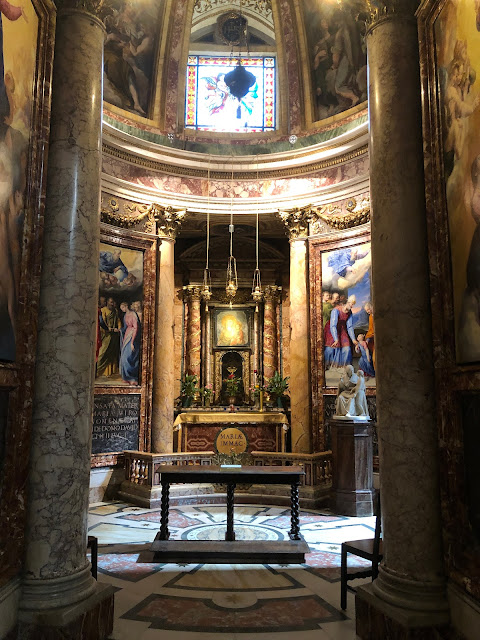【ローマ】ジェズ教会 アタナシウス・キルヒャー Roma - Chiesa del Gesu, Athanasius Kircher
ジェズ教会の左奥の一角に、小さな礼拝堂があり、そこにストラーダの聖母がある。
この聖母像は、13世紀から14世紀にかけて作られたフレスコ画で、もともとは別な教会にあったがそこから剥がされて、今は額縁に収めらている。古いイコンの雰囲気を残している。
In the far left corner of the Jez Church is a small chapel, where the Virgin of Strada is.
This statue of Our Lady is a fresco made between the 13th and 14th centuries, originally in a different church, but has been stripped from it and is now framed. It retains the atmosphere of an old icon.
イエズス会のことは、これまでは断片的にしか知らなかったが、ウィリアム・バンガードの『イエズス会の歴史』を読んで、その壮大な物語を知ることができた。
長いイエズス会の歴史の中でも、創立者のデ・ロヨラらザビエルは別として、最も印象に残った人物は、アタナシウス・キルヒャーだった。
キルヒャーは、1602年に現在のドイツのカッセン州に生まれて、フルダという町にあったイエズス会の学校で学んだ。
若い頃から優れた学者でもあり、神聖ローマ皇帝によってケプラーの後任としてウィーンに招かれたが、その反対者によって阻まれて、以降はローマでその生涯を過ごした。
I knew only a fragment of the Jesuits until now, but I was able to learn the epic story by reading William Vanguard's History of the Jesuits.
In the long Jesuit history, apart from the founders De Loyola and Xavier, the most memorable person was Athanasius Kircher.
Kircher was born in 1602 in what is now the state of Cassen, Germany, and studied at a Jesuit school in the town of Fulda.
He was also an excellent scholar from a young age and was invited to Vienna by the Holy Roman Emperor to replace Kepler, but was blocked by his opponents and spent his entire life in Rome.
キルヒャーはイエズス会の司祭であり、厳格なカトリック教徒であったが、知的関心の広い人物で、東洋学、地質学、医学、音楽など、様々な分野で膨大な研究を行なった。
日本でも多くの人がキルヒャーには関心を持っていて、ジョズリン・ゴドウィンの『キルヒャーの世界図鑑』は1986年に日本語版の初版が出版されたが、現在も書店でその再販を目にすることができる。
ゴドウィンによれば、キルヒャーは物事の起源について特に強い関心を持っていて、西洋音楽の起源、火や水の起源、言語や宗教の起源などの研究に熱心だった。
キルヒャーは、古代エジプトの宗教がその後のギリシャ・ローマのみならず、インドや中国や日本などの宗教の起源になったと考えていた。
前にナヴォーナ広場の時に紹介した、キルヒャーが教皇からオベリスクの文字の解読を頼まれたということにも、そうした背景があった。
Kircher, a Jesuit priest and strict Catholic, was an intellectually interested person who conducted extensive research in various fields such as oriental studies, geology, medicine, and music.
Many people in Japan are also interested in Kircher, and Joslyn Godwin's "Kircher's World Picture Book" was first published in Japanese in 1986, but it is still seen in bookstores for resale. be able to.
According to Godwin, Kircher was particularly interested in the origins of things, and was keen on studying the origins of Western music, the origins of fire and water, and the origins of language and religion.
Kircher believed that the religion of ancient Egypt was the origin of religions such as India, China, and Japan, as well as the subsequent Greek and Roman religions.
That was also the reason why Kircher was asked by the Pope to decipher the obelisk characters, which I introduced earlier at Piazza Navona.
キルヒャーは、ヘルメス神学にも深い関心を持っており、ヘルメス・トリスメギストゥスが書いたと当時考えられていてメルメス文書にも通じていた。
しかし、その内容は厳密に言えばカトリックの教義とは反する部分も多い。キルヒャー本人は、それらの内容はあくまでも研究対象としか考えていないとしていたようだが、果たして本当にそうだったのだろうか。
キルヒャーは、1678年以降に病に悩まされるようになってからは、ロヨラが記した『霊操』の実践に専念するようになり、1680年に亡くなり、その遺体はこのジェズ教会に埋葬された。
キルヒャーがその生涯で収集した様々な文物を展示するキルヒャー博物館がその後作られて、そこは19世紀までは世界で有数の研究施設に数えられていた。
現在では、キルヒャーは中世科学と近代科学の橋渡しをした重要な人物の一人とされている。
Kircher was also deeply interested in Hermes theology, and was also familiar with the Mermes document, which was thought to have been written by Hermes Trismegistus at the time.
However, strictly speaking, there are many parts that are contrary to Catholic doctrine. Kircher himself seemed to think that those contents were only the subject of research, but was he really so?
Kircher began to suffer from illness after 1678, when he devoted himself to the practice of Loyola's "The Spiritual Exercises" and died in 1680, whose body was buried in the Jez Church. Was done.
The Kircher Museum was subsequently built to display the various artifacts Kircher collected during his lifetime, and was one of the world's leading research facilities until the 19th century.
Kircher is now regarded as one of the key bridges between medieval and modern sciences.






コメント
コメントを投稿